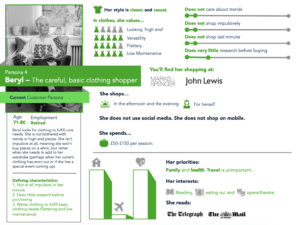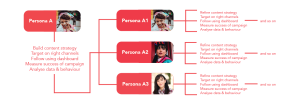
Buyer personas help to improve the relevance of your digital marketing campaigns across organic, paid and earned media.
Below you are going to find out how.
Defining buyer personas will keep you focused on addressing customer needs instead of what you think your customers need to hear.
Too often marketers use their gut feeling to make assumptions about their customers.
As a result, they use corporate-speak and buzzwords that don’t really mean anything to their customers.
While the internet provides an incredible opportunity for even small businesses to connect with large audiences, it has also created a very crowded space.
If you want to remain relevant in today’s busy marketplace, you must find a unique way to stand out.
We believe that in order to win your customers’ hearts, you first need to understand their MINDs.
What are Buyer Personas?
A buyer persona is a detailed description of your target customer.
This includes an understanding of who they are, what they like and value and what motivates them, but also what they perceive as barriers to buying from you.

The digital personas we build at Digivate are not hypothetical or fictional characters, they are real people, rooted in real data.
MIND persona audiences are receptive, predictable and profitable.
The MIND approach focuses on targeting real people using data. It begins with a hypothesis and is continuously refined to reach users on an individual level. By integrating this approach across SEO, content, PPC, and paid social, MIND personas act as the common thread in digital strategies. The key is reflecting the audience’s own beliefs to capture their attention and highlight benefits. As customer behaviours change, MIND personas evolve through constant updates based on real data, ensuring they stay relevant and effective.
What are Buyer Personas Used for?
Buyer personas are used to create better sales pages, better blog posts, better emails, and ad campaigns. And in turn, allow businesses to enjoy much higher conversion rates.
How To Create A Buyer Persona
Step 1: Start with Data-Backed Assumptions
Begin by forming a hypothesis about your audience that can be confirmed using your current website analytics (e.g., Google Analytics, Google Ads). These assumptions can be based on dimensions like:
- Gender
- Age
- Location
- Income
- Interests/Affinities
- Channels (Social Media, Organic, etc.)
- Active Hours Online
- Device (mobile, tablet, desktop)
- Brand Affiliation
- Monthly Value
- Family Setup
- Industry
- Buying Patterns (one-off or repeat buyers)
- Purpose of Visit (conversion, research, discovery)
Example of Assumption:
“Peer-to-peer lenders will visit at least 3 content pages before converting.” This assumption can help shape content strategies or guide media teams in creating multi-tier marketing campaigns.
Step 2: Validate Your Assumptions
Once you have 1-3 assumptions, use your client’s website data to either confirm or disprove them.
How to Validate:
If 70% or more of the audience fits the assumption, you can confidently proceed to the next stage.
Step 3: Identify Clusters
After validating your initial assumption, begin clustering by grouping your audience based on shared properties or behaviors.
Clustering helps you say, “If a person does X, they are also likely to do Y,” allowing you to better understand your audience holistically and refine your marketing approach.
Step 4: Expand Data Externally
With a comprehensive understanding of your website visitors, extend your research beyond your client’s site to confirm there are additional potential customers similar to your current audience.
Tools for External Validation:
- YouGov (paid) – Deep insights on consumer behaviours
- Consumer Barometer – Free tool by Google for understanding internet usage
- SimilarWeb – Global market intelligence across devices
- Google Surveys – Survey-based insights
- AnswerThePublic – Free tool for identifying popular questions around your topic
Step 5: Define Your Buyer Personas
Once your data is confirmed, work with your team to create detailed buyer personas. These personas will be visually illustrated to ensure clarity.
Step 6: Build a Lean, Adaptive Strategy
As buyer behaviour evolves, so should your marketing strategy. Your core persona may shift, requiring real-time adaptation of your resources. We’ll help establish a dynamic system to keep your buyer profiles current.
Step 7: Execute & Test
Run your marketing campaigns for a defined period, ensuring each campaign aligns with the SMART goals (specific, measurable, attainable, relevant, timely). Test how well your strategy resonates with your target personas.
Step 8: Assess & Adjust
If the campaign meets your goals, continue with it. If not, review and revise your strategy to better align with your evolving audience insights.
Our Approach To Buyer Personas at Digivate
Our approach to personas is different from other agencies [and we think it’s much better, too].
We built the unique persona-first MIND approach for 2 reasons:
1. The customer research process is flawed
Traditional marketing research relies heavily on the consumer self-reporting what they think, feel and believe.
The problem with this approach is that humans are contradictory creatures who say one thing but do the opposite. This is why marketers can’t blindly rely on consumer surveys or focus groups to understand their target audiences.
2. Agencies don’t know how to create effective personas
The majority of agencies treat personas like a box-ticking exercise and build “set it and forget it” assets that are never actually used effectively in their marketing activities.
We do better.
Our approach has helped our clients to target 10,000 users with personalised messages and convert them into loyal advocates of their brand.
We use digital personas for two reasons:
- To identify where your audiences are active online (so that you can finetune and scale your targeting)
- To sculpt the messaging that best speaks to their needs and motivations (so that you can ignite the feeling of ‘Wow, this brand really understands me, I can trust it’ in your target audience)
Think of it like reflecting your customers’ minds and hearts right back at them. Our mirroring-approach grabs your customer’s attention leading to more conversions and sales.
The problem with generalised one-size-fits-all marketing is that you can’t make a second first impression:
If you can’t engage your potential customers in a relevant and contextual manner, you will lose their trust and interest. And once you have lost someone’s interest, it’s hard to get that back.
Let’s look at exactly how our MIND personas are different and what is the benefit for you …
#1 MIND Personas Are Real People
The digital personas we build are not hypothetical or fictional characters, they are real people, rooted in real data.
Instead of only asking your prospects a set of questions, we also look at their behaviour online.
We usually start with profiling people who have bought from you in the past. By looking at your website analytics, we can see the nature of the queries coming into your site, who visits your site, when do they visit and what are their interests and affinities.
Why do you need this information?
The more data you can collect about your audience to find consistencies and patterns – the easier it will be to construct your real personas and integrate them into your marketing.
[Unfortunately, many clients come to us with an idea of their perfect target audience, which actually turns out not to be the case.]
#2 MIND Personas Are Built for the Age of Rapid Change
Your customers’ buying habits are changing all the time.
Businesses often find that their main persona is overtaken by an unexpected buyer group, in which case a reallocation of resources may be required.
We can help you to establish the systems and processes needed to form a constantly updated picture of your buyers.
Below is a 3-part roadmap to show how we gather information of your buyers to guide your marketing efforts:

#3 MIND Personas Are Incredibly Scalable
Unlike other agencies, we don’t create “set it and forget it” assets. We want your personas to guide your marketing, not just lie aimlessly on your computer drive.
By continually analysing the behaviours and patterns amongst your target audience, we gather more data and learn more about your audience.
As we learn about each persona group, we iterate the persona into further versions of the persona.
The diagram below shows how the workflow is rolled out.

MIND buyer personas not only allow you to personalise your marketing at scale but also meet your customers’ needs across all digital touchpoints.
For example, if Persona A2 converts best on Facebook, you can scale that ad campaign and increase your revenue massively.
Why Are Buyer Personas So Important for Your Business?
Buyer personas allow you to take the guesswork out of your marketing, so you can stop wasting money.
Personas inform you of what your business should be doing to help potential customers in their buying journey so you can grow your business.
By understanding your customers better, you can create marketing and sales strategies built around your customers’ objectives, day-to-day challenges and ‘pain points’ rather than doing what you think is best and hoping it will work.
Why are Buyer Personas so Important in Modern Marketing?
Buyer personas are important because it’s difficult to cut through the clutter in an age of information overload.
The more specific and personalised your marketing is, the easier it is to actually get people’s attention.
In other words, personalised marketing is the key to your marketing success. And buyer personas lie at the heart of any personalised marketing strategy.
Below we look at how we use buyer personas in our SEO services, PPC management, content marketing and social media advertising.
How to Use Buyer Personas to Improve SEO
Buyer personas are the most underused SEO asset and often the missing piece of your SEO strategy.
Why?
Because buyer personas will help you to create problem-solution content.
Many businesses don’t know what the purpose of SEO content is because they don’t know their customers’ problems.
So, their content can’t help their customers.
You can use buyer personas to create problem-solution content that both addresses your customers’ frustrations and provides them with an instant solution to that problem (which is your product or service).
We use buyer personas to expand our keyword research from outside the typical industry-based keywords to include additional search phrases that may not be directly related to your products or services, but what your products or services can help with.
Example of generic search phrase: “send money to Australia service”
Example of persona-driven search phrase: “how to check if online money transfer company is trustworthy”
Companies often miss important questions like the above when developing SEO strategies and as a result miss out on valuable traffic.
We’ve seen that using persona keyword data in our SEO strategies helps to reduce bounce rates and increase conversion rates.
How to Use Buyer Personas to Improve PPC
All our PPC campaigns address at least 1 of our buyer persona’s goals or needs.
We often create dozens of campaigns with different messages and formats, targeting different types of people on all suitable platforms.
This type of personalisation makes it easier for us to get customer attention and improve conversions for our clients.
Our unique MIND buyer persona research allows for incredibly detailed targeting options, where we can truly personalise our ads at scale.
Your buyer personas’ goals are important even if they don’t relate specifically to your product’s features.
These buyer needs can form the basis of your top-funnel campaign, which helps you to get in front of your audience before your competition.
Buyer personas will help to hone your ad messaging, tone of voice, creative, define the most suitable advertising platforms and determine the best times of the day to advertise.
We’ve seen that without thorough buyer persona research, it would be difficult to come up with appropriate non-service-related terms your target audience is actually searching for when they are trying to find your service or product.
How to Use Buyer Personas to Improve Content Marketing
Your customer needs are the foundation of your content marketing.
Once you know what makes different people buy from you, you can create better content (these are blog posts, PDF downloads for lead capture, tools, email campaigns etc)
Each persona may have a slightly different buyer journey and messaging they relate to, which we take into account when building integrated content marketing strategies.
At Digivate, we make sure that our content is mapped to your sales funnel (also called buyer journey) and that the content is intertwined with SEO keywords.
In sales and marketing, content mapping is a term that refers to the process of mapping marketing content to each stage of the buyer’s journey.
Content mapping involves strategically crafted marketing materials that drive customers to take a particular action.
Content mapping is an essential part of lead nurturing.
We consider what your target audience wants to achieve during awareness, consideration and action stages.
How to Use Buyer Personas to Improve Social Media Advertising
Our MIND buyer personas will save you a lot of time and money running test campaigns that try to figure out your ideal audiences.
With us, you’ll already have the customer data needed for audience segmentation.
Thanks to our unique persona building process, you will already be equipped with the following information when you start your paid social campaign:
- What formats will your target audience be most responsive to?
- What key messages should you include in the creative?
- What are the key demographics, associations and interests of your target audience?
- What time of day your ideal customer is more likely to be online?
We can help you craft paid social campaigns to target each persona.
For example:
If you know that Digital Executive Dave takes the bus to work at 8.15 am, you can make an informed assumption that this persona will be checking their social media profiles on their way to work.
From here, you could run relevant social ads between 8 am-9 am on a weekday targeting this persona.
One more thing:
In social media you really have two target audiences:
- End-users
- Promoters
End-users are those people who would benefit from your product or service.
Promoters are people and influencers, who share and engage with your content, helping you to amplify our reach organically and, as a result – reach new people that you may have never otherwise reached.
PRO TIP! Getting in front of influencers’ audiences organically will help with more efficient paid social effort, as the leads are already ‘warmed up’.
In order to grow your audience on social media platforms, you need to create content for both audiences – end-users and promoters.
The more entertaining or insightful your content is, the more people will share it.
To appeal to ‘promoters’, we recommend having a good mix of brand-related and entertaining content.
Summary
Whether you’re developing a paid search campaign, organic SEO strategy, or simply crafting social media content, all successful marketing starts with understanding your target audience.
We understand the complex nature of consumer behaviour. We can make your marketing more effective by tailoring your message to the right audience on the right channel.
We can also join all aspects of marketing (across owned, paid, and earned media) to achieve a common business goal.
Integrated marketing ensures that all messaging and customer experiences are unified, consistent and centred around the customer’s needs.



